Abortion statistics, England and Wales: 2020
Updated 4 November 2025
Applies to England and Wales
1. Key events
| Date | Key event |
|---|---|
| October 1967 | Abortion Act 1967 passed. Introduced by David Steel and supported by the government under a free vote. It legalised abortion on certain grounds, by legalised practitioners, in England, Wales and Scotland. The act came into effect on 27 April 1968. |
| November 1990 | The Human Fertilisation and Embryology Bill lowered the gestation limit for abortions from 28 weeks to 24 weeks. This is the currently accepted point at which the fetus is considered viable outside the mother’s body. The act came into effect on 1 April 1991. |
| June 2017 | Northern Ireland funding scheme introduced, to provide funded abortions in England and Wales, for residents of Northern Ireland. In cases of hardship, travel costs are also covered. Funding is provided by the Government Equalities Office and HM Treasury. |
| June 2018 | Women in Wales, and from 28 December 2018 women in England, can take the second of the two abortion pills, misoprostol, at home. This brought England and Wales in line with Scotland, which allowed the second pill to be taken at home from October 2017. |
| December 2018 | Abortion legalised on certain grounds, in the Irish Republic, up to 12 weeks gestation and later if the woman’s life or health is at risk. The law came into effect on 20 December 2018. |
| October 2019 | Abortion in Northern Ireland decriminalised after a free vote by Westminster MPs in July 2019. The suspended Northern Ireland Executive did not return by 21 October 2019, meaning the amendment introduced by Stella Creasy was passed into law through The Northern Ireland (Executive Formation etc) Act 2019 on 22 October 2019. |
| March 2020 | Women in England and Wales can take both abortion medications, mifepristone and misoprostol at home, without the need to first attend a hospital or clinic. This has been temporarily approved by the Secretary of State for Health and Social Care to limit the transmission of coronavirus (COVID-19) from 30 March 2020 and by the Welsh Government’s Minister for Health and Social Services from 31 March 2020. |
| March 2020 | The Abortion (Northern Ireland) Regulations 2020 came into force on 31 March 2020. The regulations introduce a new legal framework for abortion services in Northern Ireland. |
2. Key points in 2020
There were 209,917 abortions for women resident in England and Wales, the highest number since the Abortion Act was introduced.
2.1 Figure 1: Abortions, numbers, England and Wales, 2010 to 2020
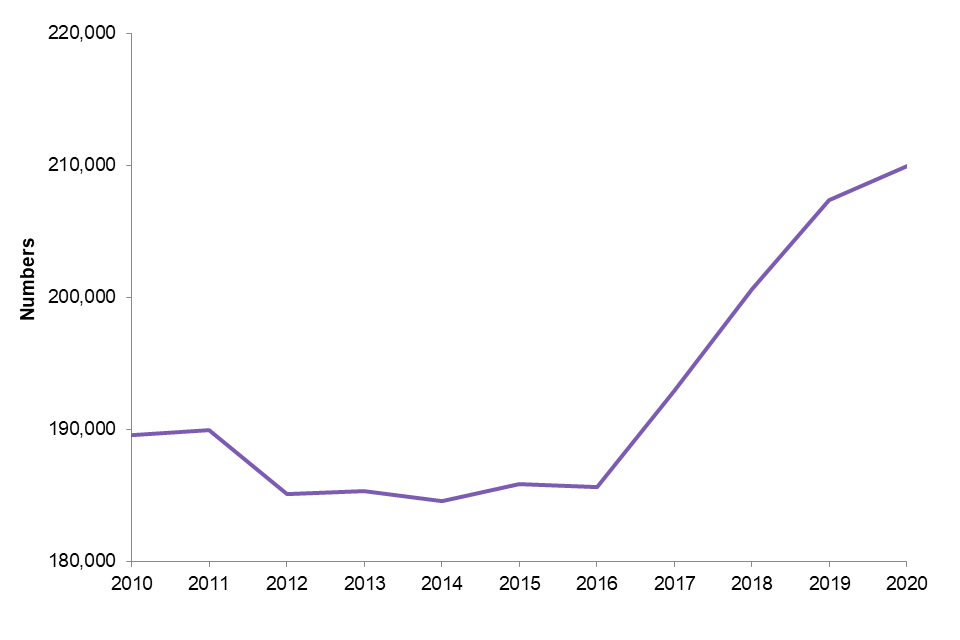
The age standardised abortion rate for residents is 18.2 per 1,000 women, the highest rate since the Abortion Act was introduced.
2.2 Figure 2: Abortions, rates, England and Wales, 2010 to 2020

The abortion rate for women aged under 18 has decreased compared to 2019 (from 8.1 to 6.9 per 1,000 between 2019 and 2020) but has increased for women over 35 (from 9.7 to 10.6 per 1,000 between 2019 and 2020).
2.3 Figure 3: Abortions, rates, under 18 and over 35, England and Wales, 2010 to 2020
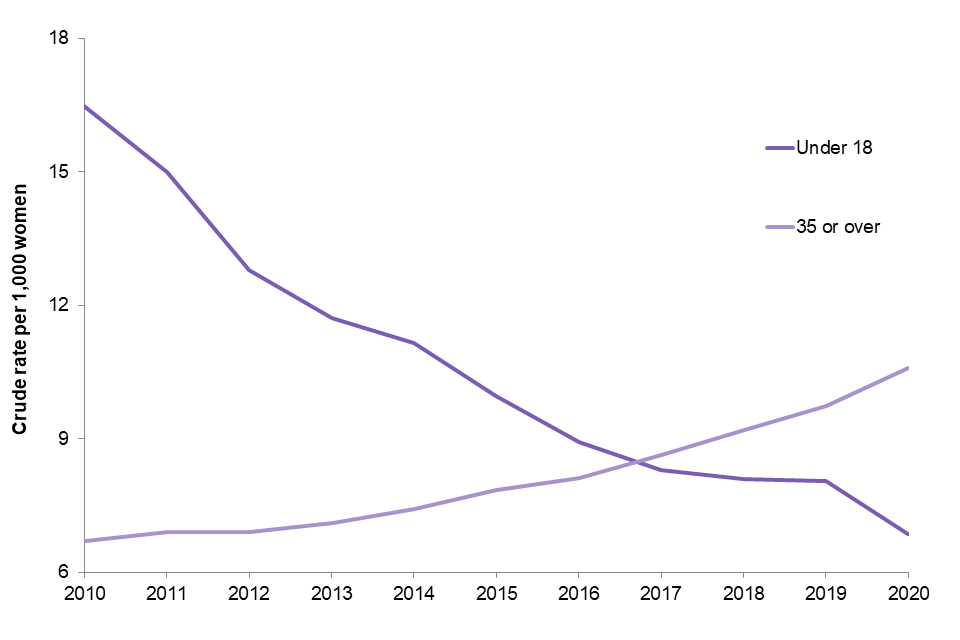
99% of abortions in England & Wales were funded by the NHS in 2020, with 77% of abortions taking place in the independent sector.
2.4 Figure 4: Abortions, purchaser, percentages, England and Wales, 2010 to 2020

85% of abortions were medically induced; which increased from 73% in 2019, and increasing by 42 percentage points since 2010.
2.5 Figure 5: Abortions, procedures, percentages, England and Wales, 2010 to 2020
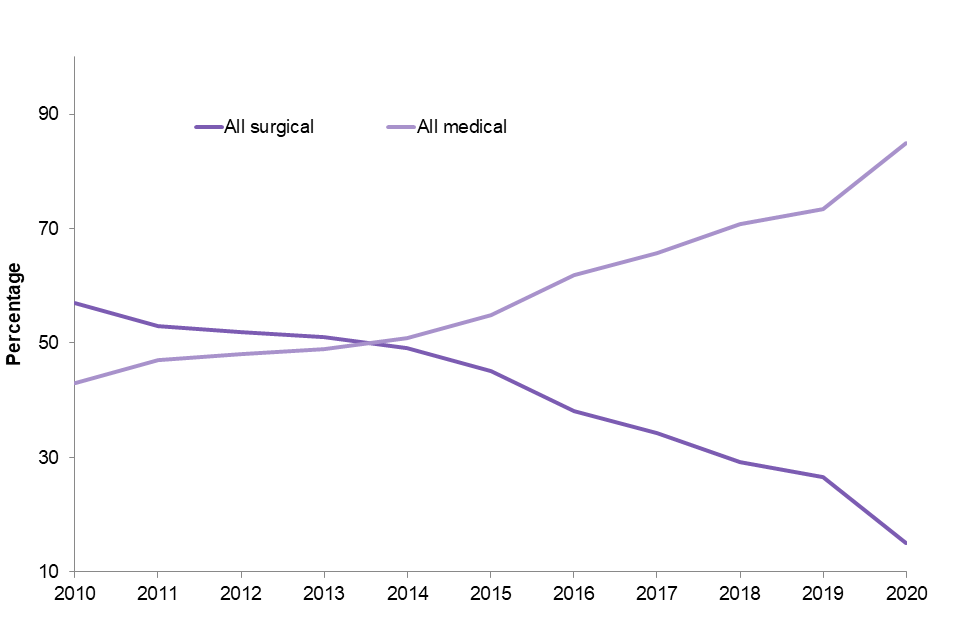
3. Introduction
This report provides statistics on abortions recorded in England and Wales in 2020. The information presented is based on abortion notification forms (HSA4) submitted by clinics and hospitals to the Chief Medical Officer (CMO) at the Department of Health & Social Care (DHSC) together with forms submitted to the Welsh CMO. DHSC monitor the forms to ensure that there is full compliance with the legislation set out in the Abortion Act, 1967.
The COVID-19 pandemic has had an impact on numbers of abortions, and method of abortion. Further information is set out in the different sections below, where relevant.
An additional, one-off report Abortion statistics during the coronavirus pandemic was published on 10 September 2020 covering provisional statistics on abortions recorded during January-June 2020. This report updates and finalises the statistics presented in the September 2020 publication.
3.1 Further information
Further details on the legislative context of the Abortion Act, in addition to methodological and technical information on the data can be found in the Guide to Abortion Statistics, in Abortion statistics for England and Wales: 2020.
3.2 Previous publications
The Department of Health and Social Care (DHSC) has published abortion statistics annually since 2002. Statistics for years from 1974 to 2001 were published by the Office for National Statistics (ONS) in their Abortion Statistics Series AB, numbers 1 to 28. The reports for 1991 to 2001 are available electronically on request to abortion.statistics@dhsc.gov.uk. Statistics for years from 1968 to 1973 were published in the Registrar General's Statistical Review of England and Wales, Supplement on Abortion.
The most recent versions of the publication are available from the GOV.UKwebsite.
Abortion statistics cover the period January to December and are published annually. The next publication will be in June 2022, and will cover January to December 2021. For further information or to provide any feedback on the publication, please contact us at abortion.statistics@dhsc.gov.uk.
4. Commentary
Unless specified, the following commentary, charts and tables relate only to abortions in England and Wales, for residents of England and Wales, in 2020.
4.1 Overall number and rate of abortions
210,860 abortions were reported in England and Wales in 2020, the highest since records began. The vast majority of these abortions (209,917) were to residents of England and Wales. This represents an age-standardised abortion rate (ASR) of 18.2 per 1,000 resident women aged 15 to 44. This is the highest rate recorded, exceeding the previous peak in 2019, (18.0 abortions per 1,000 resident women aged 15 to 44). (Table 1 and Figure 6).
Figure 6: Age Standardised abortion rate per 1,000 women aged 15 to 44, England and Wales, 1969 to 2020
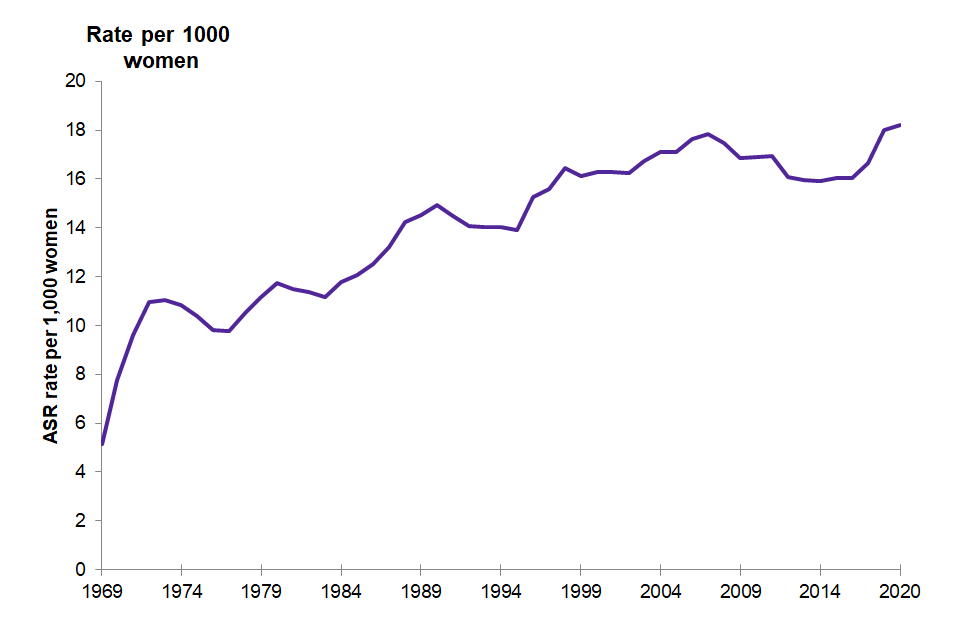
4.2 Age
The abortion rate in 2020 was highest for women aged 21 (at 30.6 per 1,000 women). In 2019 the highest rate was for women aged 22 (31.6 per 1,000 women), and in 2010 it was highest for women aged 19 and 20 (both at 33 per 1,000 women).
Figure 7: Abortion rate per 1,000 women by single year of age, England and Wales, 2010 and 2020

There has been an increase in the rates for all ages 23 and above. The largest increases in abortion rates by age are amongst women aged 30 to 34 which have increased from 16.5 per 1,000 in 2010 to 21.9 per 1,000 in 2020.
Abortion rates for those aged under 18 have declined over the last ten years (from 16.5 to 6.9 per 1,000 between 2010 and 2020). The decline since 2010 is particularly marked in the under 16 age group, where the rates have decreased from 3.9 per 1,000 women in 2010 to 1.2 per 1,000 women in 2020. The abortion rate for 18 to 19 year olds has also declined from 30.7 per 1,000 women to 22.1 per 1,000 women in the same period (Table 3b).
4.3 Marital status
81% of abortions in 2020 were for women whose marital status was given as single, a proportion that has remained roughly constant for the last 10 years. 51% were to women whose marital status was given as single with a partner. This proportion has remained similar in recent years (Table 3a.v).
4.4 Ethnicity
77% of women having abortions reported their ethnicity as White, 9% as Asian, 7% as Black, 4% as Mixed and 2% as Other. Ethnicity was recorded on 95% of the forms received for 2020 (Table 3a.vi).
4.5 Area of residence within England and Wales
By region of residence, rates of abortion are highest in the North West (21.0 per 1,000 women aged 15 to 44) and lowest in the South West (15.2 per 1,000 women aged 15 to 44). (Figure 8).
Figure 8: Age Standardised abortion rate, per 1,000 women aged 15 to 44, by region in England and Wales, 2020
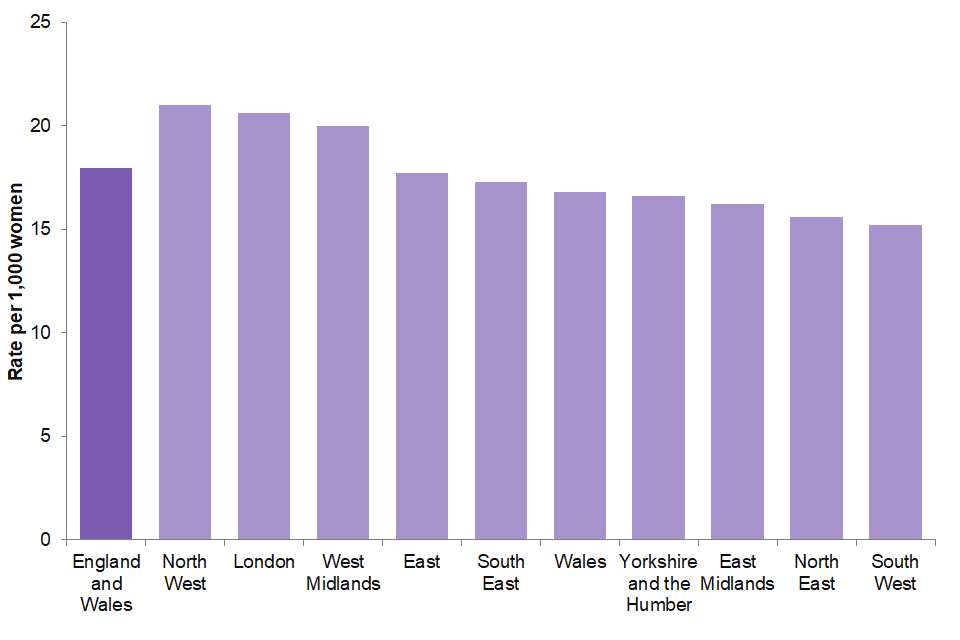
4.6 Location and funding of abortions
In 2020, 22% of abortions were performed in NHS hospitals. The percentage performed in approved independent sector clinics under NHS contract increased in line with recent years, from 74% in 2019 to 77% in 2020, making a total of 99% of abortions funded by the NHS. The remaining 1% were privately funded. (Table 3a.i and Figure 9).
Figure 9: Percentage of abortions by purchaser/provider, England and Wales, 1981 to 2020
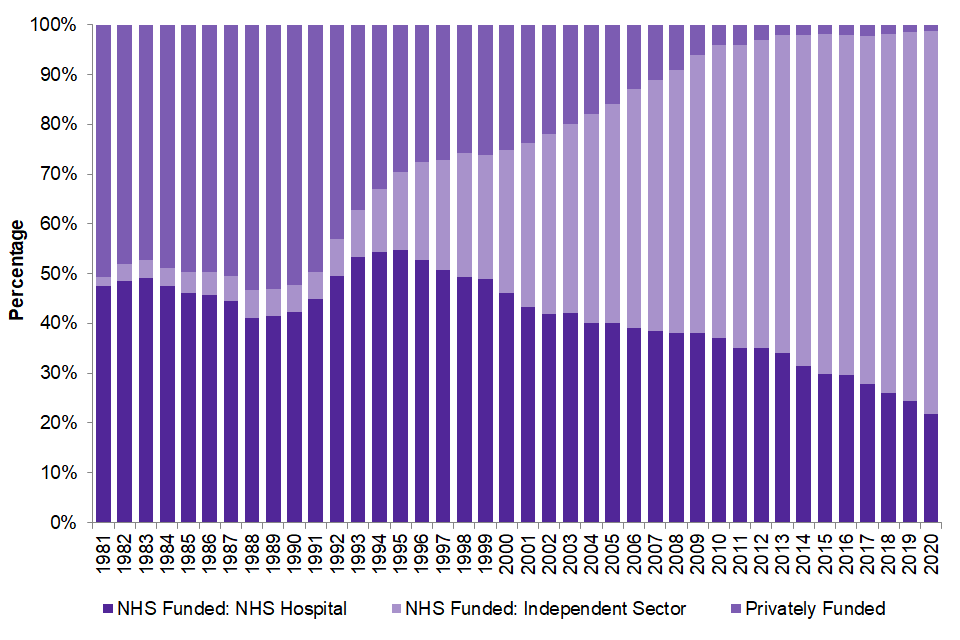
The proportion performed in the independent sector under NHS contract has increased almost every year since this information was collected in 1981, while the proportions of NHS hospital and private abortions has fallen over this period.
4.7 Statutory grounds for abortion
Under the Abortion Act 1967, a pregnancy may be lawfully terminated by a registered medical practitioner in approved premises, if two medical practitioners are of the opinion, formed in good faith, that the abortion is justified under one or more of grounds A to G. (Table A). For more information about the grounds for abortion, see the Glossary and page 4 in the Guide to Abortion Statistics.
Table A: Grounds for abortion
| Ground | Definition |
|---|---|
| Ground A | That the continuance of the pregnancy would involve risk to the life of the pregnant woman greater than if the pregnancy were terminated. |
| Ground B | That the termination is necessary to prevent grave permanent injury to the physical or mental health of the pregnant woman. |
| Ground C | That the pregnancy has NOT exceeded its 24th week and that the continuance of the pregnancy would involve risk, greater than if the pregnancy were terminated, of injury to the physical or mental health of the pregnant woman. |
| Ground D | That the pregnancy has NOT exceeded its 24th week and that the continuance of the pregnancy would involve risk, greater than if the pregnancy were terminated, of injury to the physical or mental health of any existing child(ren) of the family of the pregnant woman. |
| Ground E | That there is substantial risk that if the child were born it would suffer from such physical or mental abnormalities as to be seriously handicapped. |
| Ground F | To save the life of the pregnant woman. |
| Ground G | To prevent grave permanent injury to the physical or mental health of the pregnant woman. |
The proportion of abortions performed under different grounds has remained similar to previous years. In 2020, 98.1% of abortions (205,930) were performed under ground C. A further 1.5% were carried out under ground E (3,083 abortions, a decrease of 100 since 2019), with 0.4% (776 abortions) under ground D. The remaining grounds account for very few abortions; 128 in total across grounds A, B, F and G. (Table 2). Most of the overall increase in the number of abortions is the result of ground C abortions increasing.
The vast majority (99.9%) of abortions carried out under ground C alone were reported as being performed because of a risk to the woman's mental health. These were classified as F99 (mental disorder, not otherwise specified) under the International Classification of Disease version 10 (ICD-10).
4.8 Legal abortions performed under ground E
Ground E abortions are those performed because of fetal abnormality at any gestation. There were 3,083 abortions performed under ground E in 2020. This is a slight fall since 2019, when there were 3,183 (2%) abortions performed under ground E (Table 3a).
In 2020, 73% of ground E abortions were performed medically and 85% of all abortions were performed medically. This is in comparison to 2019 when 73% of both ground E and all abortions were performed medically (Tables 9c and 7a).
There were 229 (7%) ground E abortions at 24 weeks and over (Table 9b).
The age group with the highest proportion of abortions performed under ground E is 35 and over (3% of abortions for this age group were performed under ground E) (Table 2).
There was a total of 4,495 conditions mentioned on ground E forms in 2020. This is an increase from 3,863 in 2019. The medical diagnoses are coded to the International Classification of Diseases (ICD-10). For more information on issues with the reporting of ground E abortions see the Guide to Abortion Statistics, in the link for Abortion statistics for England and Wales: 2020 (page 7).
Congenital malformations (see Glossary), were the most common medical condition mentioned on HSA4 forms, making up 55% of conditions mentioned. Chromosomal abnormalities counted for 27% of conditions mentioned (see Table 9a).
4.9 Gestation period
Figure 10: Percentage of abortions by gestation, England and Wales, 2010 to 2020
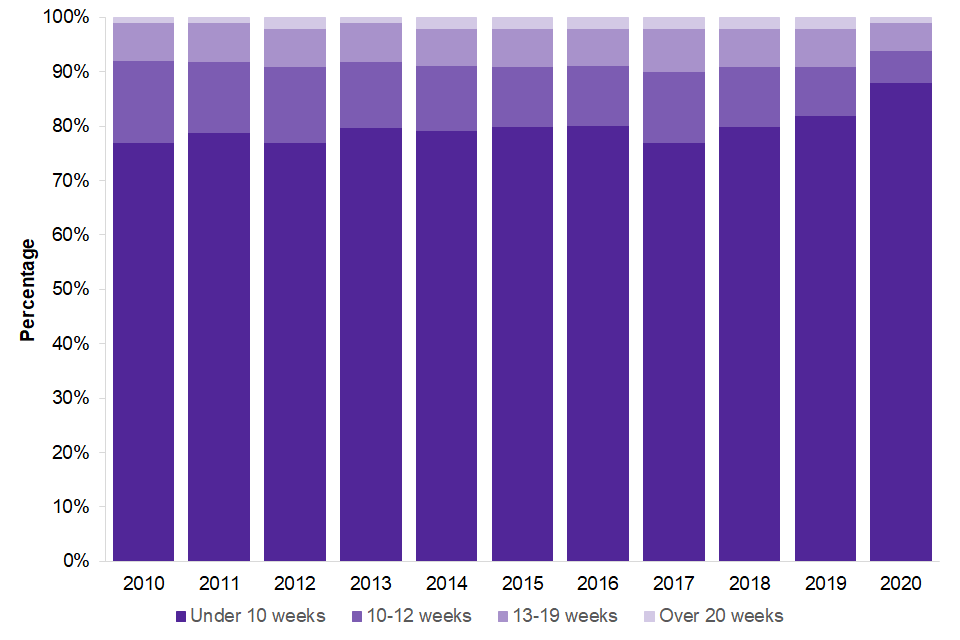
The proportion of abortions that are performed at under 10 weeks has continued to increase since 2010. In 2020, 88% of abortions were performed under 10 weeks, increasing from 82% in 2019 and 77% in 2010. In comparison, abortions performed at 10-12 weeks decreased from 9% in 2019 to 6% in 2020. The percentage performed at 20 weeks and over decreased from 2% in 2019 to 1% in 2020. (Table 3a.iii).
The legal limit for a woman having an abortion is 24 weeks gestation. This is the point at which the fetus is viable outside the mother's body. Abortions may be performed after 24 weeks in certain circumstances, for example, if the mother's life is at risk or the child would be born severely disabled. Abortions where gestation is 24 weeks or over account for a very small number of abortions (0.1% of the total). There were 236 such abortions in 2020. (Table 5).
4.10 Method of abortion
Different methods can be used to terminate a pregnancy, depending on the gestation, and other circumstances relating to the individual woman. There are medical methods which involve the use of drugs (for example Mifepristone) and there are surgical methods, such as vacuum aspiration or dilatation and evacuation. (See Glossary and Guide to Abortion Statistics).
Figure 11: Percentage of abortions by method, England and Wales, 2010 to 2020

Medical abortions accounted for 85% of total abortions in 2020, an increase of 12 percentage points from 2019. There has been a continuing upward trend in medical abortions since 1991, when Mifepristone was first licensed for use in the UK. (Table 3a.iv). There has been an additional effect during 2020 due to the COVID-19 pandemic – more information on this is set out in the paragraphs below.
Early medical abortions are defined as taking place within the first 10 weeks of the pregnancy using medical methods. Until late March 2020, the first stage of treatment had to be administered at an NHS hospital or independent sector abortion clinic approved by the Secretary of State for Health and Social Care. Since June 2018 for Wales and December 2018 for England, women have been allowed to administer the second stage of treatment for early medical abortions at home.
From 30 March 2020, the Secretary of State for Health and Social Care approved temporary measures in England to limit the transmission of COVID-19 by approving the use of both pills for early medical abortion at home, without the need to first attend a hospital or clinic. Similar measures were put in place by the Welsh Government’s Minister for Health and Social Services on 31 March 2020.
Since the temporary approval of both pills for early medical abortion without needing to first visit a hospital or clinic, the percentages of different methods used to administer abortions have changed (although it is worth noting the general increase in medical abortions over time. Taking both medications at home has become the most common procedure, accounting for 47% of all abortions during the period April to December 2020. At the same time, there has been a large increase in the percentage of medical abortion overall, accounting for 88% of abortions for the last three quarters (April to December) of 2020 compared to 77% of the first quarter (January to March) of 2020. This also compares to 74% for the last three quarters (April to December) of 2019.
Figure 12: Percentage of abortions performed by method, residents of England and Wales, quarterly 2020
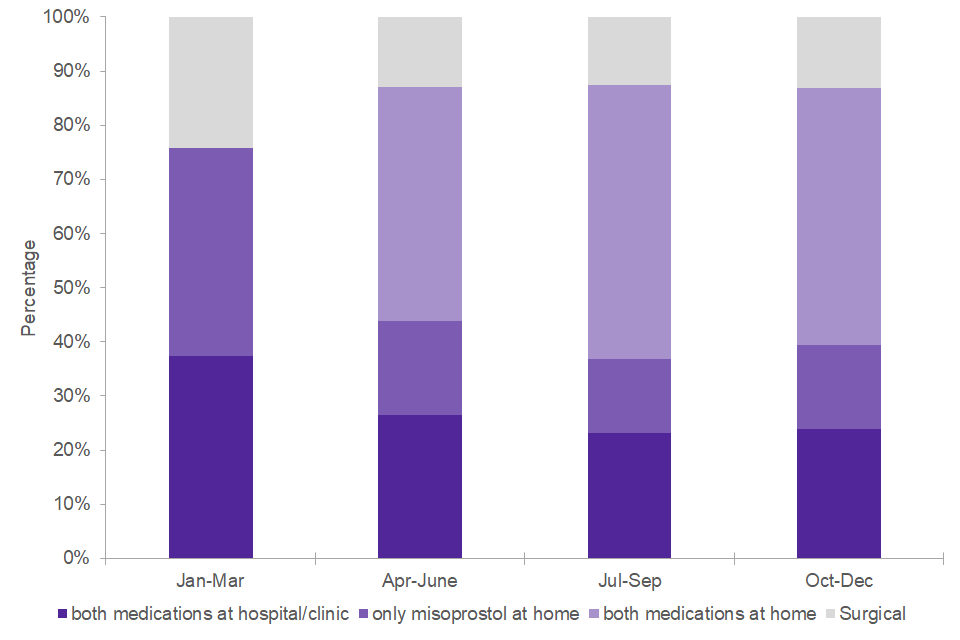
For abortions at 22 weeks and over, feticide is recommended by the Royal College of Obstetricians and Gynaecologists, prior to the evacuation of the uterus, to stop the fetal heart. In 2020, of the 1,329 abortions performed at 22 weeks and over, 61% were reported as preceded by a feticide and a further 36% were performed by a method whereby the fetal heart is stopped as part of the procedure.
4.11 Previous abortions
In 2020, 42% of women undergoing abortions had had one or more previous abortions. The proportion has increased steadily from 34% in 2010 (Table 3a.ix and Table 4b).
The percentage of women aged under 18 who had one or more previous abortions has decreased from 8% in 2010 to 7% in 2020. The percentage of women aged 30 or over, who had one or more previous abortions has increased from 44% in 2010 to 50% in 2020 (Table 4b).
There is large variation in rates of repeat abortions across local authorities. The proportion of women who had a repeat abortion in 2020 ranged from 19% (City of London) to 51% (Croydon). This variation could be due to a range of factors, including random variation, differing demographics or the impact of local policy decisions. See Tables 10 and 11 for a wide range of additional analysis at local authority (LA) and Clinical Commissioning Group (CCG) level.
4.12 Previous obstetric history
In 2020, 58% of women undergoing abortions had had one or more previous pregnancies that resulted in a live or stillbirth, up from 50% in 2010 (Table 3a.vii). 22% of women had a previous pregnancy resulting in a miscarriage or ectopic pregnancy, up from 16% in 2010.
4.13 Complications
Complications were reported in 247 out of 209,917 cases in 2020, a rate of 1 in every 850 abortions (1.2 per 1,000 abortions), which is a decrease from 2019 (1.6 per 1,000), and a decrease since2010 (2 per 1,000). The rate of surgical complications increased from 1.7 in 2019 to 1.9 in 2020 but decreased for medical complications, 1.6 in 2019 to 1.1 in 2020. The decrease in the medical abortion complication rate coincides with the uptake of both medications at home. Due to how complications are recorded, for terminations where either both or the second stage is administered at home, complications may be less likely to be recorded. Please see the guide to abortion statistics for more information on reporting abortion complications. (Table 8).
4.14 Selective terminations
In 2020, there were 65 abortions which were selective terminations, (See Glossary), a decrease from 126 in 2019. 72% of the selective terminations were performed under ground E.
4.15 Women resident outside England and Wales
This section covers abortions carried out in England and Wales to women who are residents of other countries.
In 2020, there were 943 abortions to women recorded as residing outside England and Wales, a decrease from 2,135 in 2019. Most non-residents came from Northern Ireland (39.3%) and the Irish Republic (20.6%). The large decrease in the number of abortions for residents outside of England and Wales may be explained by travel restrictions in place throughout the year relating to the Coronavirus pandemic (Table 12a).
4.16 Abortions for women from Northern Ireland
On 29 June 2017 the government announced that it would fund, via the Government Equalities Office (GEO), abortions for women ordinarily resident in Northern Ireland, where abortions were only available in very limited circumstances.
This provision for Northern Irish women currently remains in place despite the decriminalisation of abortion in Northern Ireland. This followed a free vote by Westminster MPs in July 2019 during the period that the Northern Ireland Executive was suspended (effectively becoming law when the Executive did not reconvene before 21 October 2019). This required the Northern Ireland Office (NIO) to provide a framework for abortion services to come into effect from 31 March 2020.
In 2020 there were 371 abortions for women from Northern Ireland, a significant decrease from the 1,014 in 2019. Current levels remain substantially lower than the peak of 1,855 Northern Ireland resident abortions in 1990.
4.17 Abortions for women from the Irish Republic
In May 2018 the ban on abortion in the Irish Republic was overturned, repealing the eighth amendment of the constitution. The law came into effect on 20 December 2018 meaning that abortion is permitted in the first 12 weeks of pregnancy and in later cases where the woman's life or health is at risk, or in cases of fatal fetal abnormality.
As a result of this change and travel restrictions during the COVID-19 pandemic, in 2020, the number of women travelling to England and Wales for abortions declined from 2,879 in 2018 to 194 in 2020 (Table 12a), a decrease of 93%.
The proportion of abortions for residents of the Irish Republic performed under ground C was 68%, a decrease of 15 percentage points from 83% in 2019. The proportion of abortions under ground E increased from 17% in 2019 to 32% in 2020 (Table 12e). In 2020, 6% of abortions were performed at less than 10 weeks gestation, falling from 17% in 2019.
Figure 13: Number of abortions for residents of Northern Ireland and the Irish Republic: 1970 to 2020

4.18 Abortion rates by Index of Multiple Deprivation, (IMD), deciles
The Index of Multiple Deprivation (IMD) is the single official measure of relative deprivation available for England and provides the most effective way of understanding the differences in levels of deprivation between areas. There are seven domains of deprivation, which combine to create the IMD by ranking each small area from most deprived to least deprived, typically dividing areas into ten equal groups (or ten deprivation deciles). Decile 1 is the most deprived and decile 10 the least deprived. For further information about the indices see: English Index of Multiple Deprivation 2019
Women living in the most deprived areas are more than twice as likely to have abortions than women living in the least deprived areas. The rate in the most deprived decile is 26.8 per 1,000 women, compared to 12.1 per 1,000 women for women living in the least deprived areas. (Figure 14).
This is true across different age groups and different regions of England (Table 14 and Figure 14).
Figure 14: Abortion rate per 1,000 women by IMD decile, England, 2020

4.19 Age range analysis by Index of Multiple Deprivation, (IMD), deciles
The trend of rates increasing as levels of deprivation increase is also persistent across all age ranges (Figure 15).
Figure 15: Abortion rate per 1,000 women, by age and IMD decile, England, 2020

4.20 Glossary
| Term | Definition |
|---|---|
| Age standardised rate | A method to standardise the comparison of rates within populations where there are structural differences in age. (See Guide to Abortion Statistics for further details). |
| Chief Medical Officer (CMO) | The CMO is the most senior government advisor on health matters in the UK. The CMO advises government on public health issues. This extends to recommending policy changes affecting the law governing abortion and advising doctors who perform abortions, regarding the interpretation of that law. There are four in total, each one advising either Her Majesty's Government, (CMO for England and medical adviser to the United Kingdom government), the Northern Ireland Executive, the Scottish Government or the Welsh Government. |
| Congenital malformation | Congenital malformations are also known as birth defects, congenital disorders or congenital anomalies. They are separated into two main types: structural disorders, which affect the shape of a body part and functional disorders, which affect how a body part works. Congenital malformations may include both structural and functional disorders. |
| Crude rate | The number of abortions in a specified population per year, divided by the total number of women in that population. |
| Grounds | The grounds for abortion are specified in Table A above and in the Abortion Act 1967. |
| Feticide | An abortion is a procedure to end a pregnancy. Feticide is the destruction of a fetus in the uterus. |
| Medical abortion | Two medicines are taken, the first is mifepristone and is taken at the clinic[footnote 1]. The second is misoprostol, which may be taken at the same time or within 3 days of the first medicine. It may be taken either at the clinic or at home under amendments to the Abortion Act. |
| Selective terminations | Pregnancies may result in more than one embryo being implanted in the womb. In such cases, the outcome of the pregnancy may be more successful if the number of fetuses is reduced. This reduction usually occurs at about 12 weeks gestation and is referred to as selective termination. |
| Surgical abortion | The pregnancy is removed in an operation by a doctor. There are two types. Vacuum aspiration issued between 3 and 12 weeks, where the fetus is removed by suction. Dilatation and Evacuation is used between 13 and 24 weeks, where the fetus is removed using forceps. |
-
From 30 March 2020, the Secretary of State for Health and Social Care approved temporary measures in England to limit the transmission of COVID-19 by approving the use of both pills for early medical abortion at home, without the need to first attend a hospital or clinic. ↩
